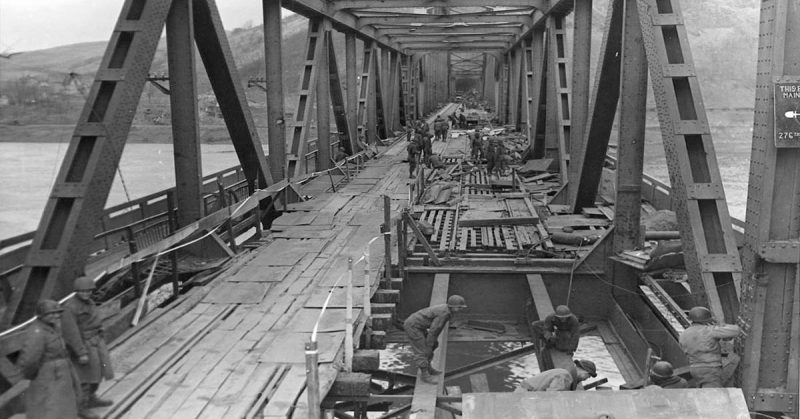The Ludendorff Bridge was a long, steel bridge crossing the Rhine in Germany. Little remains of it, 71 years after the German army destroyed it to prevent the Allies advance.
Dan Yolo of Santa Rosa was standing on it as the Germans took it down. He was a 20-year-old Army sergeant who didn’t grasp the historical import of what was happening as the enemy took extreme measures to slow the Allied forces as they moved deeper into German territory.
Now 91, the former Santa Rosa High School student did the only thing that made sense at the time. “I put it in high gear and took off,” said the retired, self-employed trucker.
He isn’t sure how he made it off the collapsing bridge on the afternoon of March 17, 1945. He somehow found himself on the bank by the edge of the water.
Yolo was responsible for fourteen Army engineers he was supervising as they tried to repair the bridge while the Germans spent ten days trying to blow it up with planted explosives, bombs, mortar shells, and anything else they could throw at it. They even used the first tactical launch of Hitler’s V-2 ballistic missile.
After pulling himself up the bank, Yolo helped rescue the injured and recover the bodies of the dead. There were approximately 200 US Army soldiers on the bridge when it collapsed. 28 of them were killed, and 93 were injured.
He helped a sergeant he knew well. The sergeant seemed shaken, but healthy. Still, he died soon after. Yolo suspects he suffered a lethal concussion.
Some time later, he went searching for his unit. Of the fourteen engineers under his command, only four survived without injury.
Two weeks after being captured by the US Army, the Ludendorff bridge was lying at the bottom of the Rhine.
Andy Rooney, the war correspondent and future “60 Minutes” contributor, reported the destruction in his article on March 18, 1945, “The Ludendorff Bridge crumpled into the Rhine River yesterday afternoon, 10 days to the hour after the Ninth Armored Division captured it and crossed the river.”
Yolo was quoted in The Press Democrat on March 20th. He said the destruction of the bridge “was quick. Damned quick. It piled up just like match sticks. I never saw anything like it in my life, and I never want to again.”
Thinking back on the loss of the bridge, Yolo says, “I didn’t give a damn about the bridge. It’s the men you lose. You never get them back.”
Over the last 70 years, Yolo has avoided speaking about his experiences in the war and specifically about the battle at Remagen. His late wife, Margaret “Peggy” Ann (Batten) Yolo, taught their children not to ask about it.
Lately, some of Yolo’s sixteen grandchildren and great-grandchildren have been asking about what he did in the war, and he has been more forthcoming about his experiences. He’s never been involved in veteran’s organizations or activities, but this year he plans to ride in the Veterans Day parade in Petaluma.
The sacrifices that Yolo and his unit made at the Ludendorff Bridge might have helped end the war that much sooner. Within 24 hours after setting a bridge over the Rhine, the US Army moved almost 8,000 troops along with armored vehicles and trucks across the Rhine to stop a German counter-offensive and achieve victory in the Battle of the Bulge.
Conquering the bridge and crossing the Rhine was a morale boost for the Allies and demoralizing to the Germans. Hitler executed five of his officers which he blamed for the failure to hold the bridge and then the further failure to destroy it before it was captured.
After the collapse of the bridge, Army engineers created a pontoon bridge that the Army used to get across the Rhine.
44 days after the Ludendorff Bridge was destroyed, on April 30, Hitler was dead. On May 7, Germany surrendered.
Lt. Col. Edgar Bell wrote in his journal that the Ludendorff Bridge was “the most valuable structure ever owned by the US Army.”
The battle was the setting for a 1969 highly fictionalized movie, starring George Segal, Ben Gazzara, and Robert Vaughn.
Yolo came back to Santa Rosa after the war and worked on his parents’ egg farm before buying a truck with his brother and starting a business hauling and selling hay. That business became Yolo Brothers Trucking.
Yolo joined the Army because they needed soldiers for the war effort. He went and followed orders; including doing what he could to keep the Ludendorff Bridge standing and capable of handling traffic. He’s aware that he could easily be among those that lost their lives on that bridge, The Press Democrat reported.
“But I lucked out and I’m still here,” he said. He’d like to forget about that bridge and the events surrounding its collapse, but after 71 years, the memory is not likely to go.
